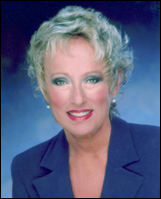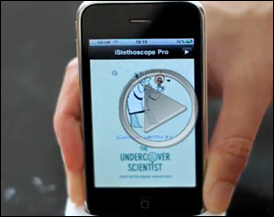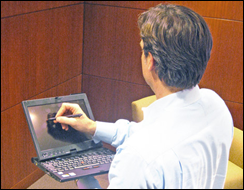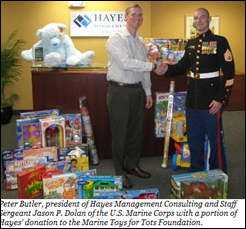HIStalk Practice Interviews Scott Decker
Scott Decker is president of NextGen Healthcare.

Do you believe that the HITECH Act will deliver the goods, both in terms of improving care and lowering costs through technology and for stimulating the economy?
I think those are two fairly dramatically different issues. I think it certainly is doing more than has been done in the 20 years I’ve been in the industry in getting attention brought to the value of automating electronic medical records and the processes and communication between systems. I think it’s still a little too early to tell. While the entire industry expects that it’s going to be the catalyst and it’s finally going to get everybody moving, it’s still too early to tell.
If it does what it’s intended to, which is get electronic health records in the hands of the vast majority of the physicians and vast majority of the hospitals doing physician order entry, I absolutely believe it’s going to deliver on higher quality care. I think that’s been intuitive to everybody in the industry for a long time, that if information shared across caregivers — I don’t think anybody, obviously, thought that wouldn’t improve patient care. So with that caveat, if everything happens the way the stimulus is intended to happen, yes, I think it’ll absolutely help improve care.
As far as being a stimulus, if everybody starts automating, I think you’ll see a short-term increase in healthcare IT spend. I don’t know that I’d consider that an economic stimulus. It certainly is a segment stimulus and certainly good for healthcare IT vendors. I don’t know if it’s the best use of dollars to stimulate our overall economy.
Do you think the technology’s also going to help lower cost in healthcare?
You go back once again to the intuitive things which are — will it take care of when people get testing and does it help improve the administrative flow? I think a lot of those things are going to happen fairly short term. I don’t know if it’s a major mover in the next five years on lowering costs.
In fact, it may actually increase costs in the next five years as everybody has to go through all this implementation work. Over time, I think if quality improves, lower costs go with that. I think we’ll actually see a short-term increase in costs and I think the long term is a 10- to 20-year horizon before you start to see improved overall cost in healthcare because of this initiative.
Do you have a sense of how many doctors will forego that HITECH incentives and stick with the electronic or paper systems they’re already using?
We don’t have a sense on that, so let’s just assume that 20%, maybe, of physicians have electronic health records. We definitely think this will be an accelerator. We definitely think it won’t force everybody to go off. I think it’s going to get up to the same point we would have gotten to anyhow, I just think it’s going to get up to it faster. Maybe the ultimate is 75 or 80% of physicians.
Two years ago, if we would have talked about this, you probably would have agreed it’s going to take 10 to 15 years. Maybe now we’ve changed the time horizon back to five to 10 years. I mean you still talk to them and say, “This isn’t enough to make it worthwhile.” Now maybe the pain at the end of this curve will be strong enough that even those will have to move, but I think there’s definitely a set who are still saying this isn’t enough to change my position on the value.
The HITECH legislation is aimed primarily at general medicine EMRs. Do you see anything changing for specialists?
I think if it’s successful in the primary care side in and of itself, it’ll help specialists, especially in the flow of information. You already have higher penetration of EHR on the specialty side. Those were certainly some of the more early adopters.
I have heard talk, people even revisiting the stimulus to say, “Do we need to put more incentive into the bill to apply to specialties?” I think yes, they are going to benefit maybe more than they currently perceive. Some of that’s direct, and I think some of its indirect; i.e. just the connectivity of primary care folks as they get online, I think, is going to be a benefit to them.
Hospitals and regional extension centers may eventually have a larger than expected role in which physicians implement which systems. Was that a surprise, and has NextGen’s strategy changed at all because of it?
It was definitely a bit of a surprise. I think we, and some of our peers in the industry, didn’t necessarily expect that move and maybe even scratch our head a little bit at “is that the best way to spend the money to help accelerate this”; i.e. put a middleman in the market between vendors and physicians, especially organizations that don’t exist today, that doesn’t necessarily have a lot of experience and skills implementing and deploying EHR.
But with all that said, it is what it is and yes, it has changed, rather dramatically, our strategy because it has the potential of being a key channel to getting physicians up and running. So we’re very aggressive in our planning on how to best work with the RECs and making sure they’re successful.
Clearly with hospitals, I see them much more aggressive in the last six months, also, in really solidifying their strategies on going after EHR. I was just at CHIME a couple months ago and did probably three focus groups, probably talked to 50-75 CIOs, and almost to a CIO, it’s now their top strategy. One of their top two strategies is now the deployment of EHR, certainly for owned physicians and a vast majority of the cases, to the community physicians having some sort of offering through the health system. So yes, we definitely stepped up the time we’re spending in the hospital segment and think that’s also a key distribution point.
Connectivity solutions include both HIEs and vendor-specific options, technology such as that offered by Epic. What should customers look for in planning for the future?
They definitely need what I would call a more generic HIE offering rather than a vendor-specific. I guess I would relate that comment more to our conversations with health systems, so it’s backlit from that side first. I mean, they need a solution that’s committed to connectivity, and I think everybody has come to the conclusion that you can’t dictate to your community a single EHR solution or even two or three.
Where I think connectivity is not even just about hospitals, it’s the physician communication — the physician and the hospitals, hospital to physician, and physician to physician. The health system probably ought to put in a system that facilitates that. Why need a multivendor platform to do that?
From the physician office side, you need to make sure your vendor has an open architecture and standard that’s going to easily communicate with a neutral HIE platform.
By the way, I wasn’t ruling out the fact that your vendor might have a neutral platform. So for instance, at NextGen, we invested heavily in building an HIE product. The number one criterion was it has to be open standard/open vendor model. Our clients are using a NextGen HIE solution to accomplish what I described as they need to be changing.
One of the things on the inpatient side that we’re seeing is that many vendors have seen customers satisfaction metrics drop after a big sales pitch because the vendor wasn’t able to scale up to hold all the hands of those new clients trying to implement simultaneously. Do you think that we’re perhaps creating a lot of unhappy customers because that HITECH window is so small?
Yes. I think everybody believes if things take off as we are anticipating they are, there are definitely going to be organizations that have trouble scaling. Just like you asked me what the criteria that clients ought to be looking for when they choose HIEs, probably this is an even more important one — whether to resource it to the company you’re looking at to help you with your EHR, and assuming the demand’s going to be through the roof.
What organizations are probably best prepared to scale with that and are going to be able to give you a quality installation and service and training — I think that’s going to become more and more an important criterion for selection.
Anything else you want to share about NextGen?
We’re obviously invested heavily on all the fronts you tapped on. We focused really heavily in the last 12 months on making sure we are prepared to address that scale issue. We’ve always been very focused on customer satisfaction. I think this just puts more pressure than we’ve ever had on making sure we’ve pre-invested to make sure we continue to deliver quality product implementation and clients at the end of it. You need a company that can scale, and there are fewer and fewer of us out there in the industry, I think, today.
The other thing we’ve invested really heavily on is this whole concept of HIE or interconnectivity. We’re pretty excited about the portfolio we now have between having an EHR and an EPM. They’re all on a single database that’s tied into an HIE that also has a patient connectivity piece to it so that we can really tackle what we think is going to be the ultimate game here, which is going to go quickly beyond just “how do I get my practice up and running EHR,” but “how do I get my practice up and running in a connected community.” I think that’s going to be the big game as the standards start raising. We’re real excited about what we have on that side and what we’ve already been able to do through the clients on building up that model.
















The article about Pediatric Associates in CA has a nugget with a potentially outsized impact: the implication that VFC vaccines…